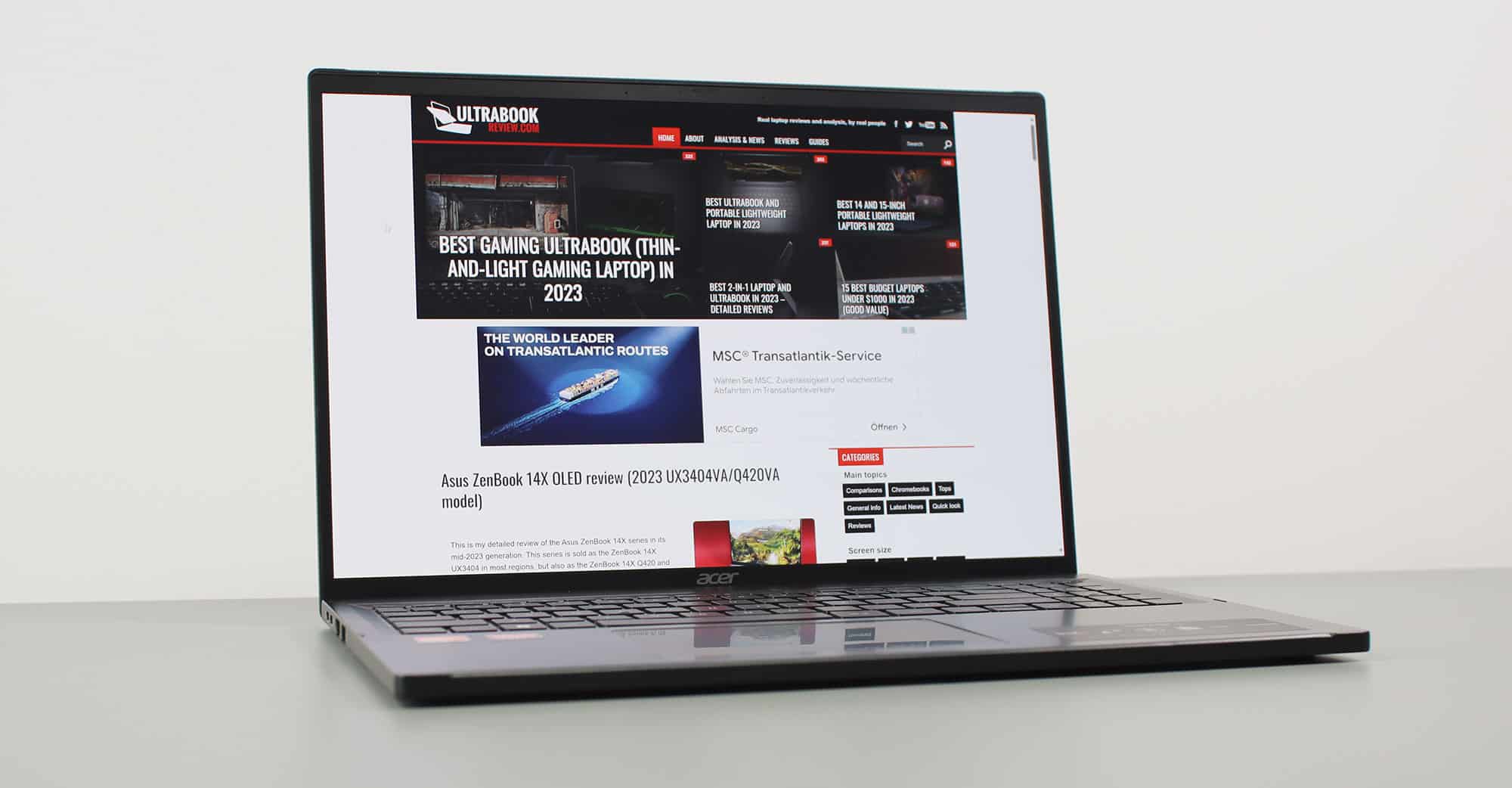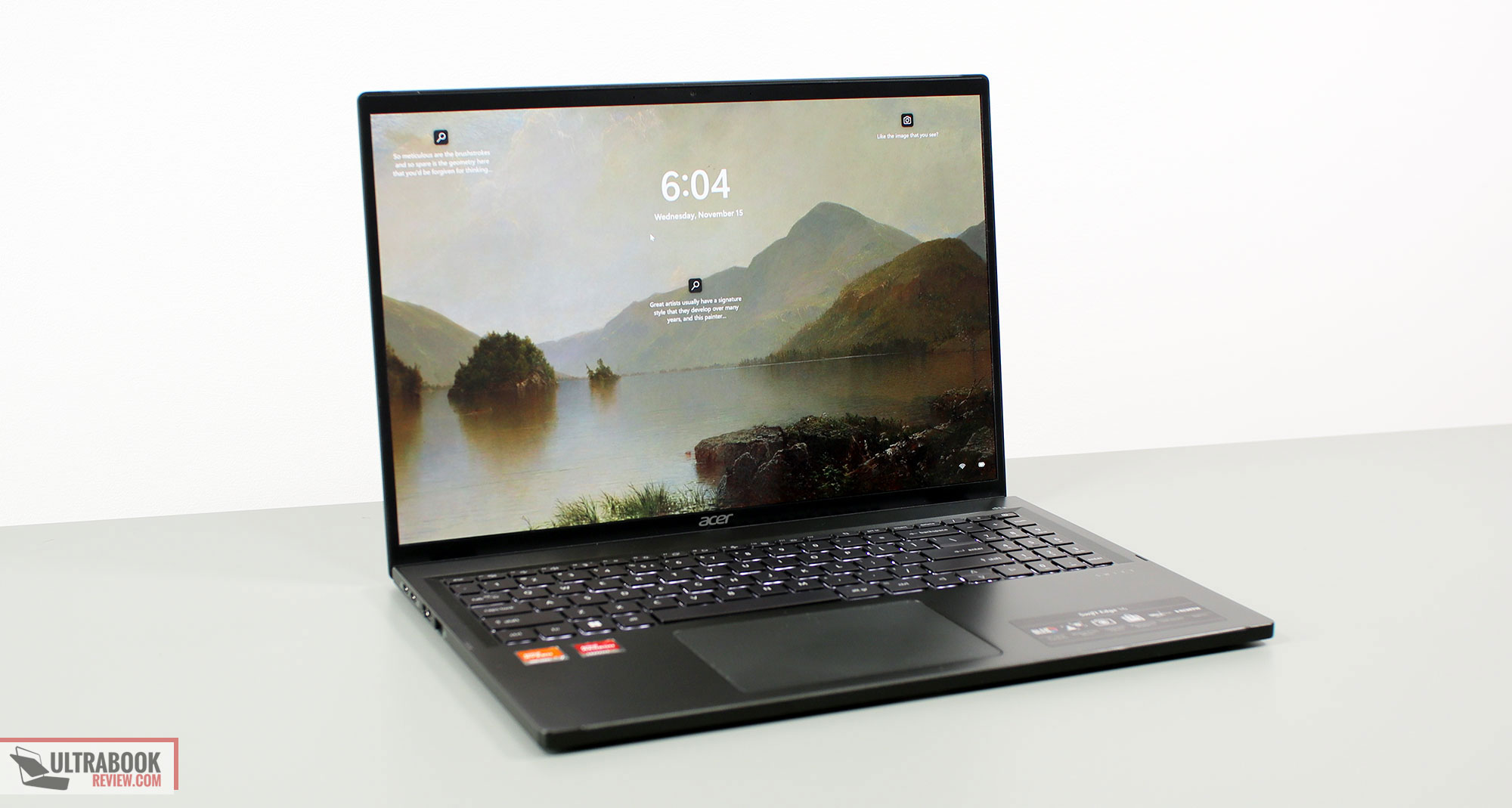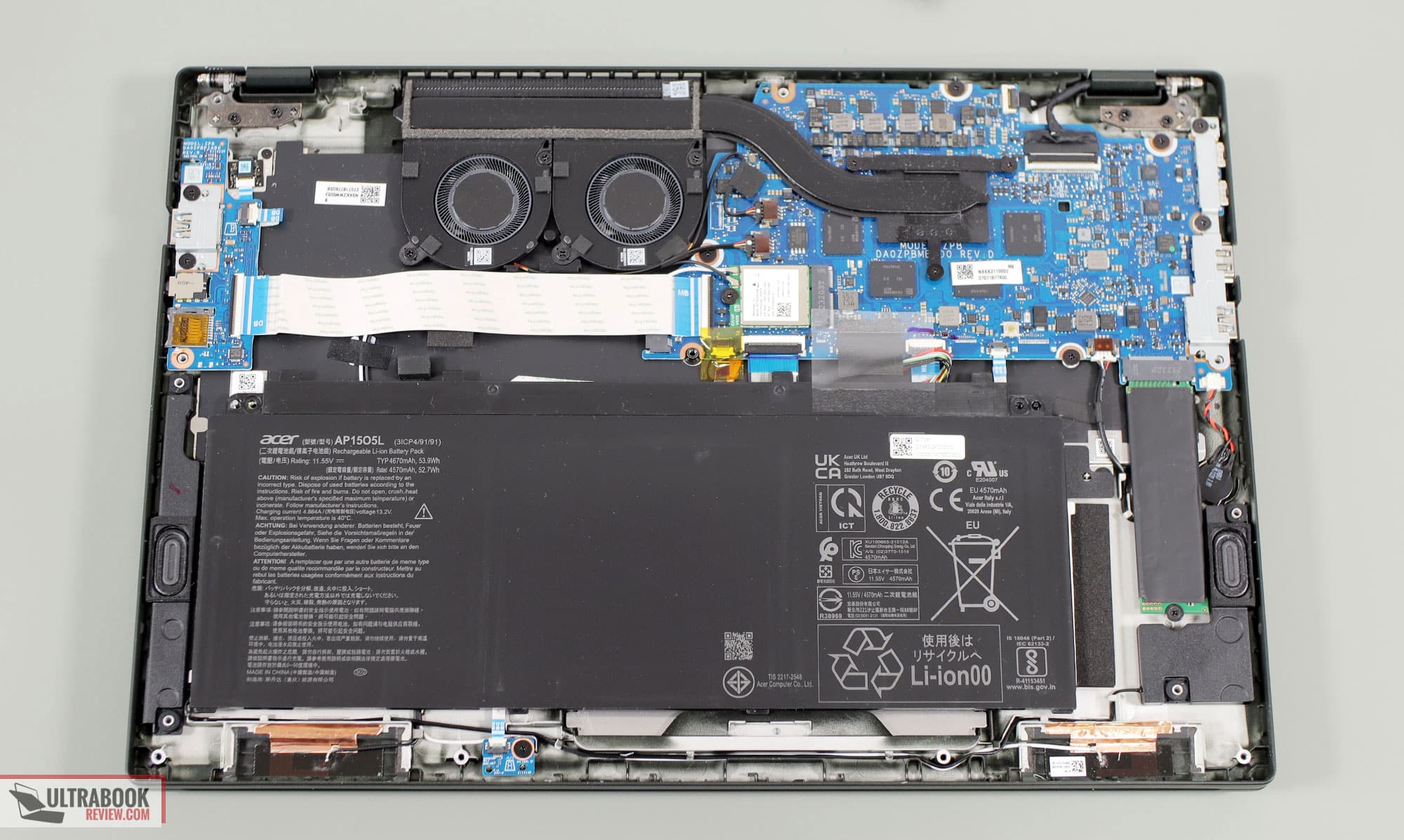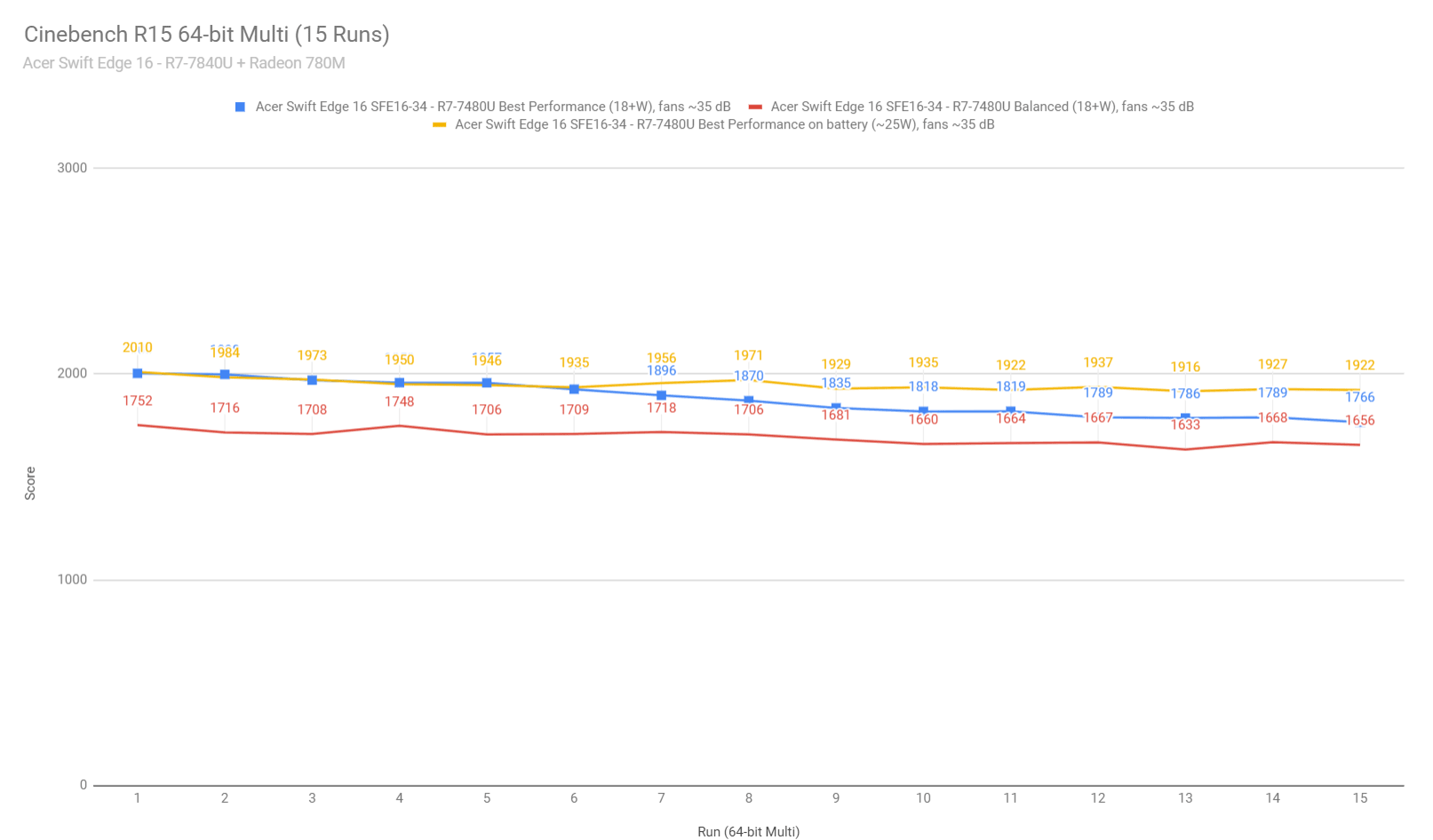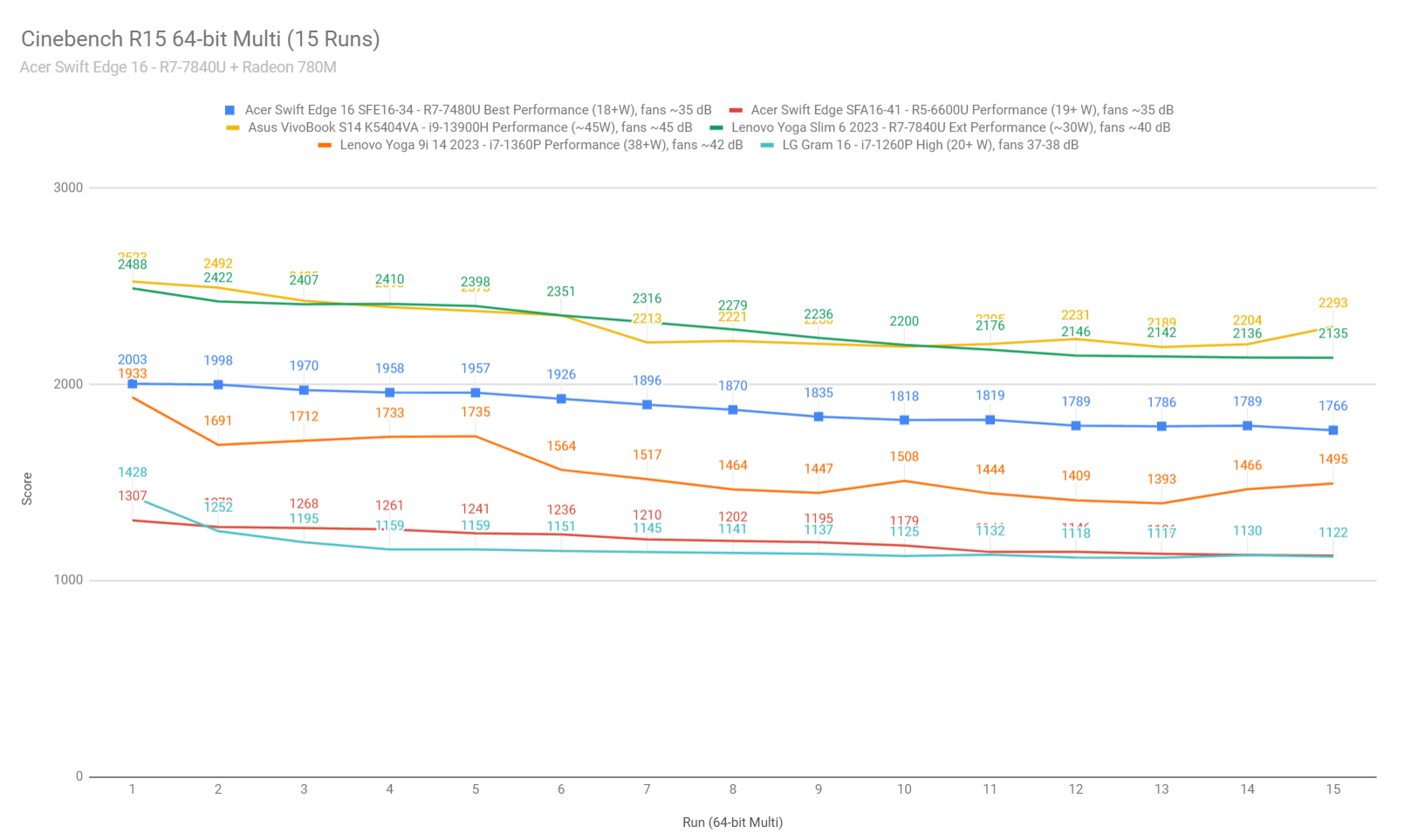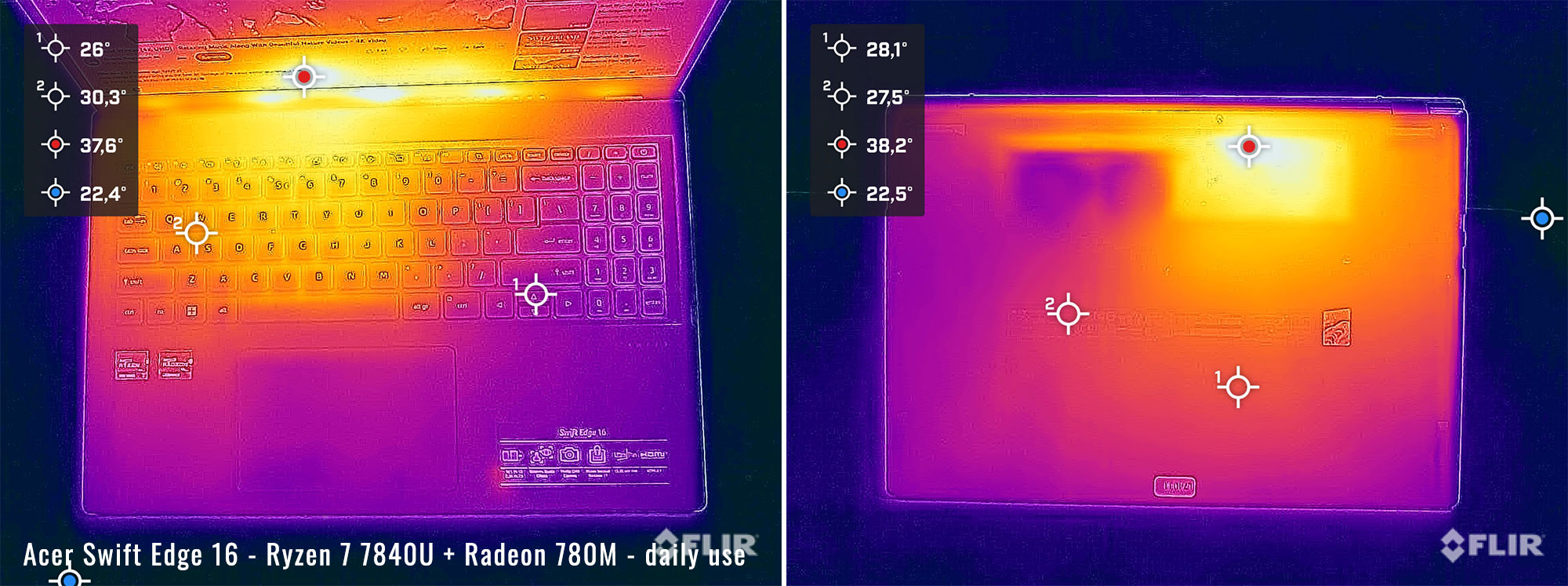This is my detailed review of the Acer Swift 16 Edge SFE16-43 generation, a lightweight and portable 16-inch laptop built on a modern AMD Ryzen U hardware platform.
I’ve reviewed a previous version of the Swift Edge in the past, and this updated model has grown in design, functionality, and performance.
At the same time, Acer are still pushing for a minimalist lightweight model here, and that means certain aspects are sacrificed in the process, to a lesser or greater extent. Among them, there’s the chassis’ overall rigidity, the typing experience, the performance in sustained loads, and the battery life.
The devil’s all in the details, though, so make sure to go through this entire review for my impressions on this Swift Edge 16 OLED, which I’ve been using almost every day for the last few weeks.
Specs as reviewed – Acer Swift Edge OLED SFE16-43
| Acer Swift Edge 16 OLED SFE16-43, 2023 model |
|
| Screen | 16 inch, OLED, 16:10 aspect ratio, non-touch, glossy, 3.2K 3200 x 2000 px, 120Hz refresh, 400-nits SDR brightness, 600-nits HDR peak, 100% DCI-P3 colors |
| Processor | AMD Phoenix Ryzen 7 7840U, 8C/16T |
| Video | AMD Radeon 780M, 12CU, up to 2.7 GHz |
| Memory | 16 GB LPDDR5-6400 (soldered), up to 16 GB |
| Storage | 512 gB M.2 NVMe SSD (SK Hynix PC801) – single M.2 2280 slot |
| Connectivity | Wireless 6E (Mediatek MT7922) 2×2, Bluetooth 5.2 |
| Ports | left: 2x USB-C 3.2 gen2, 1x USB-A 3.2 gen1, 1x HDMI 2.1, right: Noble Lock, 1x USB-A 3.2 gen1, micro SD card reader, mic/headphone |
| Battery | 54 Wh, 65W charger |
| Size | 358 mm or 14.08” (w) x 246 mm or 9.68” (d) x from 12.95 mm or 0.51” (h) |
| Weight | 2.69 lbs (1.22 kg) + .19 (42 lbs) for the USB-C charger and cables, US version |
| Extras | clamshell format with 160-degree hinge, single-fan cooling, white backlit keyboard with NumPad, 1.2 mm travel, glass ?? touchpad, 3.7 MPx QHD webcam without IR, no fingerprint sensor, stereo side-firing speakers |
Design and first look
Acer designed this laptop as a portable travel companion with a big punchy screen, and that was obvious to me from the moment I got it out of the box.
This thing weighs just 2.7 lbs, or a little over 1.2 kilos, making it one of the lightest laptops available with a 15/16 inch display. It’s lighter than a MacBook Air 15 or a Samsung Galaxy Book3 or an LG Gram 16. It’s not as compact as those 15-inch models, though, with fairly significant bezels at the top and beneath the display. But it will easily fit inside bags designed for full-size devices.
For comparison, down below I’ve also included a picture of this Swift Edge 16 vs a mid-range Asus Vivobook S15.
However, in order for this to be as lightweight as it is, some corners had to be cut. The metals used for the main chassis are rather slim, and when paired with the size of the chassis, there’s some noticeable flex in the main deck. I also noticed some creaks when handling and using the laptop, but those were rather rare. For the most part, though, the build quality is fine here, even if not on par with stronger-made devices. I’d say it’s about similar to an LG Gram.
I also like how the materials feel to the touch, with a slightly grainy texture all around. This gives the laptop excellent grip, and even does a surprisingly good job at hiding smudges. Especially when this is an almost black color. It seems to scratch and dent fairly easily, though, there are already a few marks on this unit, so make sure to pamper yours.
Ergonomics are good here as well. The screen can easily lift up and adjusted with a single hand and leans back to about 160-degrees (almost flat, but not quite), there’s a generous arm-rest area, and the edges and the front-lip are blunt and friendly to the wrists. There are also plenty of ports on the sides of this devices, which we’ll get to in a bit.
But first, I do have some gripes with this design. The rubber feet are tiny and hard and not very enough on a flat surface, there are no biometrics of any sort, and the cooling module is designed with the exhaust under the display, blowing hot air into the panel. Normally, that’s a design flaw, but not that much here due to the power settings and overall temperatures. We’ll get in-depth in the Performance and Emission sections. Nonetheless, I would have preferred a chassis with a side mounted radiator.
As for those ports, there’s almost everything you’ll want here, including USB-A and USB-C ports, a full-size HDMI, a microSD card reader, an audio jack and a Noble Lock. These are lined on the sides, where you’ll also find the status LEDs.
Overall, this laptop has really grown on me over time. Sure, it felt a little flimsy at first, but I quickly got used to the slight flex in the main chassis. And since the lid is fairly strong, I wouldn’t worry about this being too fragile or potentially breaking in my backpack. I’d still place it in a sleeve, but I do that with all my laptops.
At the same time, I enjoyed using a lightweight laptop that I could easily lug around and still benefit from a big display. But at the same time, I’d gladly take a little extra weight for a larger battery, which is offered by the competition in this class, and where the Swift Edge still falls short.
Keyboard and trackpad
Acer updated the inputs on this Swift Edge 16 SFE16-43 generation, and they’re mostly fine, but with some particularities that you must be aware off.
The keyboard is a rather standard Acer implementation, with a full-size main set of keys and a smaller NumPad at the right side. It’s not a full NumPad, though, as you can tell from the following pictures.
Personally, I preferred the simpler layout of the past Swift Edge implementations, without the NumPad, but I know some of you appreciate the NumPad on this format. I did struggle with the arrows keys, though, with those being squeezed in between the other keys and the up/down arrows being half sized. I hit the Ins and Del keys quite often instead of the right arrow, but I guess this would correct over time, with longer use.
Other than that, this is a short-stroke keyboard, around 1.2 mm or even less (I can’t find the official numbers). The keys actuate quickly, though, and the feedback is stiff. Even if I normally prefer short-stroke keyboards, I couldn’t quite meet my normal typing speed with this one.
I’d also add that this is a surprisingly loud typer, and it might attract some unwanted attention in quiet places.
The keys are backlit, of course, with single-zone white LEDs. There are two brightness levels to choose from, and none is very bright, but the upper level is fine for night use. Uniformity is fine as well, and the light doesn’t bleed out too much from under the keycaps.
However, as with most Acer keyboards, it bothers me that I have to hit a key to reactivate the lighting once it times out. This should work by placing the hands over the touchpad, or with a gentle swipe, but not on this laptop.
The touchpad is a generous surface and is supposedly made out of glass. It feels more like plastic to the touch to me, but it’s smooth and operated flawlessly during my time with it.
This surface rattles with firmer taps, though, so make sure to tap it gently, and the physical clicks are clunky and loud.
As for biometrics, there aren’t any on this notebook. That’s unacceptable in this day and age and in this segment.
Screen
This laptop comes with a 16-inch 16:10 glossy OLED 3.2K display, in a glossy non-touch variant.
This is beautiful a 10-bit panel with HDR 500 support, ~600 nits peak HDR brightness in supported activities, 100% DCI-P3 color coverage, and excellent blacks/contrast.
At the same time, this panel is only about 400-nits with normal content, so barely adequate for proper use in bright environments or outdoors, especially when also accounting for the glare and reflections. This is standard for all current OLED laptops, though.
You should also be aware that by being a non-touch OLED implementation, the graininess caused by the digitizer layer on touch OLEDs is not an issue here. Instead, the content looks crips and smooth, even texts on white backgrounds. That’s rather rare on OLED laptops.
Anyway, here’s what we got in our tests, with an X-Rite i1 Display Pro sensor:
- Panel HardwareID: Samsung SDC418B (ATNA60BX03-0);
- Coverage: 100% sRGB, 99.1% Adobe RGB, 99.6% DCI-P3;
- Type: 10-bit with HDR500, 120 Hz;
- Measured gamma: 2.21;
- Max brightness in the middle of the screen: 388.29 cd/m2 on power;
- Min brightness in the middle of the screen: 4.56 cd/m2 on power;
- Contrast at max brightness: 1:1;
- White point: 6400 K;
- Black on max brightness: 0 cd/m2;
- PWM: Yes, to be discussed.
This panel came well calibrated out of the box and turned out to be uniform in luminosity and color. Plus, since this is OLED, you don’t have to concern yourself with any light bleeding on black backgrounds.
Panel quality aside, the other particularities of laptop OLED panels should also be considered in your decision, discussed in-depth in this separate article about OLED laptops, technologies, and options.
As for the matter of PWM and flickering, yes, lower brightness settings are possible though PWM, and that impacts your eyes and brain and can cause headaches after prolonged use in dim environments. As far as I can tell, Acer doesn’t implement any option for flicker-free brightness control. At the same time, I’ve used this laptop for the last three weeks and haven’t encountered notable side-effects, which I do encounter of lower-resolution 60 Hz OLED panels. But I’d still be aware of this aspect in my decision.
Hardware and performance
Our test model is a top-specced configuration of the 2023 Acer Swift Edge 16 OLED code name SFE16-43, with an AMD Ryzen 7 7840U processor and Radeon 780M graphics, 16 GB of LPDDR5-6400 memory, and a middling 512 GB gen4 SSD.
Disclaimer: This review unit was provided by AMD for this article. We tested it with the software available as of mid-November 2023 (BIOS 1.08). At this point, this is a mature product and I doubt future software updates might change things in any significant way.
Spec-wise, this is based on the 2023 AMD Phoenix Ryzen U hardware platform. The AMD Ryzen 7840U is the top processor in this lineup, built on Zen4 architecture with 8 Core and 16 Threads, as well as RDNA3-based Radeon 780M graphics. This highly portable implementation supplies the CPU with 15-25W of sustained power in demanding loads, which is lower than most other notebooks.
Graphics are handled by the Radeon 780M iGPU, with 12 Compute Units and frequencies up to 2.7 GHz. The iGPU works at about 60% of its maximum potential in this portable chassis. If interested, this article is a more detailed review of the AMD Radeon 780M platform, in a handful of different products.
Our configuration also comes with 16 GB of LPDDR5-6400 memory. The RAM is soldered on the motherboard and non-upgradeable.
For storage, Acer opted for a fairly basic PCIe gen4 SK Hynix drive here. This is fine for regular use, but will choke with sustained transfers.
The SSD and WiFi chip are the only upgradeable components here. To get to them you need to remove the back panel, which is held in place by a couple of Torx screws.
Inside you’ll notice the motherboard with the basic thermal module, the SSD, Wifi module, battery and speakers. There’s still plenty of space left unused, around the cooling module and around the battery, which is still only 54 Wh in capacity, smaller than what you’re getting with the competition.
As far as the software goes, Acer still lacks a proper control app, but there are three performance/thermal profiles to choose from, which you can cycle between with Fn+F:
- Performance – allows the hardware to run at ~20W sustained, with the fan ramping up to ~42 dB;
- Balanced – allows the hardware to run at ~18W in sustained loads, with the fan ramping up to ~40 dB;
- Quiet – limits the CPU at ~12W to favor fan noise of sub 30 dB.
Quiet mode is fine for light use, but I’d recommend keeping the laptop on Balanced in most cases. In fact, for some reason, the middle profile actually allowed for the best power settings on this implementation, and is the one I’ve used for the tests. In theory, Performance mode should allow for higher sustained power with slightly louder fans, but somehow that wasn’t the case on this sample. Weird.
Here’s what to expect in terms of speeds and temperatures with daily chores such as streaming video, editing text, or browsing the web. Even on Quiet, the fan is intermittently on and off every minute or so, and you can hear its woosh in quiet environments.
Performance and benchmarks
On to more demanding loads, we start by testing the CPU’s performance in the Cinebench R15 loop test.
On the Performance mode, the Core i9-13900H processor peaks at ~70W of power for a few loops, and then stabilizes at around 45W of power, with temperatures in the mid to high 80s Celsius, and fan-noise levels of ~44-45 dB. These result in sustained Cinebench scores of around 2200 points.
On Standard, the system limits the fan to around 40 dBA. The CPU ends up stabilizing at 35W, with temperatures around 78-80 C, and scores of around 2050 points. That’s within 90% of the scores on Performance mode.
On Whisper mode, the CPU slowly gravitates towards 15W, with barely audible fans and temperatures in the mid-60s. At 15W, the i9 processor scores around 900 points, roughly 40% of its the Performance scores.
Finally, our sample performed very well on battery, stabilizing at around 40W of power on the Performance mode.
All these are illustrated in the graph below.
To put these in perspective, here’s how this portable i9-13900H implementation fares against other hardware platforms available in competing 14-inch thin and light laptops. This platform makes the VivoBook S 14 faster than most other options in the segment, even if the i9 doesn’t run at its full potential here, due to the 45W sustained power limit.
Furthermore, high-performance 13-inch models such as the ROG Flow Z13 and Flow X13 are also 15-20% faster in this multithreaded load.
We then went ahead and further verified our findings with the more taxing Cinebench R23 loop test and in Blender, confirming the results explained earlier.
We then ran the 3DMark CPU profile test.
Finally, we ran our combined CPU+GPU stress tests on this notebook, on the Performance profile. 3DMark stress runs the same test for 20 times in a loop and looks for performance variation and degradation over time. This unit easily passed the test, which means the performance is not impacted in longer-duration sustained loads, as the heat builds up.
Next, here are some benchmark results. We ran the entire suite of tests and benchmarks on the Performance profile on this Core i9-13900H configuration, with the screen set at its default 2.8K resolution.
Here’s what we got.
- 3DMark 13 –CPU profile: max – 5833, 16 – 5812, 8 – 5256, 4 – 3325, 2 – 1854, 1 – 968;
- 3DMark 13 – Fire Strike: 6466 (Graphics – 6908, Physics – 22303, Combined – 2542);
- 3DMark 13 – Night Raid: 23564 (Graphics – 28775, CPU – 11631);
- 3DMark 13 – Time Spy: 2549 (Graphics – 2276, CPU – 8022);
- Uniengine Superposition – 1080p Extreme: 1348;
- Uniengine Superposition – 1080p Medium: 4166;
- Handbrake 1.3.3 (4K to 1080p encode): 41.70 average fps;
- Handbrake 1.6.1 (4K to 1080p encode): 48.79 average fps;
- PCMark 10: 6294 (Essentials – 11300, Productivity – 7884, Digital Content Creation – 7716);
- GeekBench 5.5.0: Single-Core: 1872, Multi-core: 8937;
- GeekBench 6.0.2: Single-Core: 2300, Multi-core: 9944;
- CineBench R15 (best run): CPU 2029 cb, CPU Single Core 274 cb;
- CineBench R20 (best run): CPU 4521 cb, CPU Single Core 665 cb;
- CineBench R23: CPU 12705 cb (best run), CPU 11033 (10 min loop test), CPU Single Core 1728 CB (best run);
- x265 HD Benchmark 64-bit: 31.29 s.
And here are some work-related benchmarks, on the same Performance profile:
- Blender 3.01 – BMW Car scene- CPU Compute: 3m 22s ;
- Blender 3.01 – Classroom scene – CPU Compute: 8m 9s;
- Blender 3.41 – BMW Car scene- CPU Compute: 3m 15s ;
- Blender 3.41 – Classroom scene – CPU Compute: 8m 04s;
- Blender 3.65 – BMW Car scene- CPU Compute: 3m 19s ;
- Blender 3.65 – Classroom scene – CPU Compute: 8m 07s;
- PugetBench – DaVinci Resolve: 447;
- PugetBench – Adobe After Effects: -;
- PugetBench – Adobe Photoshop: 881;
- PugetBench – Adobe Premiere: 246;
- SPECviewperf 2020 – 3DSMax: 25.36;
- SPECviewperf 2020 – Catia: 23.21;
- SPECviewperf 2020 – Creo: 37.72;
- SPECviewperf 2020 – Energy: 12.39;
- SPECviewperf 2020 – Maya: 90.05;
- SPECviewperf 2020 – Medical: 18.29;
- SPECviewperf 2020 – SNX: 93.33;
- SPECviewperf 2020 – SW: 43.31;
- V-Ray Benchmark: CPU – 8288 vsamples, GPU CUDA – 199 vpaths.
This is a fair performer for daily use, multitasking, and occasional demanding loads. Because the system limits the power in sustained loads, this Ryzen 7 7840U implementation is not as capable as on higher-power designs, such as the Lenovo Yoga Slim 6 we’ve tested recently.
This is also not as fast as the Intel Core H designs of this generation, but is a proper competitor for the Intel Core P and Core U 13th-gen platforms, the kind you’ll mostly find in alternative ultraportable options.
Gaming Performance
With these out of the way, we also ran a couple of DX11, DX12, and Vulkan games on the Balanced profile of this Core i9 + Iris Xe configuration, at FHD+ resolution, with Low/Lowest graphics settings. I threw in a few other platforms for comparison.
| Low settings | Swift Edge 16 2023 – R7-7840U, Rad 780M, 17+W, FHD+ 1200p |
Yoga Slim 6 2023 – R7-7840U, Rad 780M, 30W, FHD+ 1200p |
Vivobook S 14 2023 – i9-13900H, Iris Xe, 45W, FHD+ 1200p |
ZenBook S 13 2023 – i7-1355U, Iris Xe, 20W, FHD+ 1200p |
ZenBook S 13 2022 – R7-6800U, Rad 680M, 15W, FHD+ 1200p |
ZenBook 14 2022 – i7-1260P, Iris Xe, 30W, FHD 1200p |
| Bioshock Infinite (DX 11, Low Preset) |
114 fps (66 fps – 1% low) | 140 fps (79 fps – 1% low) | 96 fps (62 fps – 1% low) | 80 fps (52 fps – 1% low) | 102 fps (63 fps – 1% low) | 70 fps (48 fps – 1% low) |
| Doom: Eternal (Vulkan, Medium Preset) |
54 fps (42 fps – 1% low) | 74 fps (52 fps – 1% low) | 38 fps (30 fps – 1% low) | 29 fps (23 fps – 1% low) | 45 fps (34 fps – 1% low) | 29 fps (15 fps – 1% low) |
| Far Cry 5 (DX11, Low Preset) |
39 fps (29 fps – 1% low) | 48 fps (36 fps – 1% low) | 32 fps (24 fps – 1% low) | 29 fps (22 fps – 1% low) | 45 fps (34 fps – 1% low) | 31 fps (22 fps – 1% low) |
| Far Cry 6 (DX11, Low Preset) |
32 fps (24 fps – 1% low) | 39 fps (29 fps – 1% low) | – | – | – | – |
| Dota 2 (DX 11, Best Looking Preset) |
63 fps (46 fps – 1% low) | 72 fps (41 fps – 1% low) | 77 fps (51 fps – 1% low) | 62 fps (32 fps – 1% low) | 74 fps (46 fps – 1% low) | 76 fps (52 fps – 1% low) |
| Shadow of Tomb Raider (DX12, Lowest Preset, no AA) |
50 fps (41 fps – 1% low) | 59 fps (34 fps – 1% low) | 41 fps (25 fps – 1% low) | 26 fps (198 fps – 1% low) | 47 fps (35 fps – 1% low) | 36 fps (23 fps – 1% low) |
| The Witcher 3: Wild Hunt (DX 11/12, Low Preset, Hairworks Off) |
*34 fps (25 fps – 1% low) | *41 fps (24 fps – 1% low) | *38 fps (27 fps – 1% low) | *29 fps (21 fps – 1% low) | 41 fps (26 fps – 1% low) | 38 fps (20 fps – 1% low) |
- Doom, Dota 2, Witcher 3 – recorded with MSI Afterburner in game mode;
- Bioshock, Tomb Raider games – recorded with the included Benchmark utilities;
- *Witcher 3 results for the 2023 models are different than on previous devices, due to the changes brought to the game by the 2023 DX12 updates and patches.
Older games are still playable here. But don’t expect to run any recent or demanding title on this sort of device. Furthermore, with lower TDP of this implementation leads to lower framerates than on the Lenovo Slim 6. But even so, this Radeon 780M configuration is able to outmatch most of the Intel-based options with Iris Xe, with only some exceptions of higher-power Core H models.
With that out of the way, let’s go through some CPU/GPU logs.
On Performance mode with the laptop sitting on the desk, the hardware stabilizes at only 15W of power, which means the GPU runs at only 1.1 GHz. That’s only about 40% if its maximum potential speeds. In theory, Performance mode should stabilize at around 20W, but that’s not the case on this sample.
In fact, the laptop worked better on the middle-level Balanced profile, where the CPU settles around 17-18W of power with games. That allow the GPU to run at 1.3 – 1.5 GHz, once more far away from the 2.7 GHz max speed possible at higher power. Despite these, the framerates are not that bad on Balanced mode, at about 70-80% of what we got on the Lenovo Yoga Slim 6, where the 780M runs at full power on the 30W profile.
Internal temperatures are excellent as well on this mode, around 65 C, with the fans spinning at sub 40 dBA.
There’s also a Quiet mode, which limits the power to 12W and further caps the performance. I wouldn’t use that for anything demanding.
Noise, Heat, Connectivity, speakers, and others
Acer implement a dual-fan single-radiator single-heatpipe thermal module here, which is quite good for this sort of portable laptop, with the extra CFM of the two fans and the long radiator.
Paired with the lower-power settings applied to the hardware, this cooling module is perfectly capable of taming the Ryzen hardware in this chassis.
As far as noise goes, here’s what to expect: sub 30 dBA for Quiet, sub 40 dBA for Balanced, 42 dBA for Performance.
As far as external temperatures go, a hotspot develops above the keyboard, near the radiator, and gets to high 40s. Everything else keeps merely warm. That includes the screen, despite the fact that the cooling system is designed to blow the hot air into the panel.
*Gaming – Balanced mode – playing Witcher for 30 minutes, fans at ~40 dB
With daily use and multitasking, the fans keep quiet, and even idle with very basic activities. I haven’t noticed coil winning on this unit, either.
As for external temperatures, the chassis keeps cool with light use.
*Daily Use – streaming Netflix in EDGE for 30 minutes, Balanced Mode, fans at 0-30 dB
For connectivity, there’s the latest-gen WiFi 6E and Bluetooth 5.2 through a Mediatek module on this laptop, which performed fine during my time with the laptop.
Audio is handled by a set of stereo speakers that fire through grills positioned on the side of the chassis. They’re rather tiny in both quality and volumes. I wish Acer would have implemented larger speakers on this device, there’s enough unused space inside, around the battery.
Finally, there’s a QHD camera placed at the top of the screen, flanked by microphones. The image quality is fine in good lighting, and meh in bad light. It doesn’t seen better than the average FHD webcams implemented by other brands these days, despite this being higher resolution. There’s also no IR with this camera, and no physical privacy cover either.
Battery life
There’s a 54 Wh battery inside this 2023 Swift Edge 16, much smaller than the norm for this class.
Here’s what we got in our battery life tests, with the screen at 120Hz and the screen’s brightness set at around 120 nits (~50 brightness).
- 5.2 W (~10 h of use) – Idle, Quiet Mode, screen at 50%, Wi-Fi ON;
- 8 W (~7 h of use) – text editing in Google Drive, Quiet Mode, screen at 50%, Wi-Fi ON;
- 7.5 W (~7 h of use) – 1080p fullscreen video on Youtube in Edge, Quiet Mode, screen at 50%, Wi-Fi ON;
- 7 W (~7-8 h of use) – Netflix fullscreen in Edge, Quiet Mode, screen at 50%, Wi-Fi ON;
- 12 W (~4-5 h of use) – browsing in Edge, Balanced Mode, screen at 50%, Wi-Fi ON;
- 40 W (~1+ h of use) – Gaming – Witcher 3, Standard Mode, screen at 50%, Wi-Fi ON.
These are fair runtimes, but not great. This would have lasted way more with a larger battery.
The screen doesn’t automatically switch from 120Hz on battery power, either, so you could perhaps set it up this manually if looking to squeeze the longest possible runtimes.
The laptop ships with a compact 65W USB-C charger. It’s a single-piece design with a long and thick cables, and an USB-C plug. A full battery charge takes less than two hours.
Price and availability- Acer Swift Edge 16 OLED
At the time of this article, the Acer Swift Edge 16 OLED is widely available in stores.
MSRP pricing in the US is roughly at $1299 for Ryzen 7 7840U/16 GB/1 TB SSD configuration tested here. The same variant goes for 1199 EUR over here in Europe and around 1299 GBP in the UK. That’s pretty competitive pricing overall.
At this point, I’m not seeing lower-tier configurations in stores, based on Ryzen 5 platforms. But those might be available later on.
Stay put for updates, and in the meantime, follow this link for updated prices and configurations in your region.
Final thoughts- Acer Swift Edge 16 OLED review
This Acer Swift Edge 16 is quite an interesting series, a lightweight and highly-portable laptop with a big screen and enough performance for daily chores and multitasking, but also for some occasional workloads and even games.
It’s not the only lightweight 16-inch laptop available in stores, but is the only one to pair a beautiful OLED display with a recent AMD Ryzen 7 7840U platform. And even if the hardware doesn’t run at its full capacity in this implementation, it’s still faster in demanding loads and in GPU tasks than the Intel Core P configurations available in competing products.
Speaking off, the main alternatives are the Samsung Galaxy Book3 Pro and the LG Gram 16, both premium lightweight designs, with either OLED (Samsung) or IPS (LG) displays, and larger batteries than the 54Wh one on the Swift. In fact, the size of the battery is my main nit with the Swift Edge 16, and has been with all the previous generations. There’s enough room inside the chassis for a larger battery that would allow for longer runtimes, and yet Acer choose not to update the battery, in order to keep this laptop a little lighter than the competition.
My other nits are with the poor audio and with the somewhat finicky build quality, this latter aspect being another consequence of chasing the ultralight moniker, and opting for thin and flexible pieces of metal for the case as a result.
So all in all, I’m not entirely sold on the Swift Edge 16 OLED, especially when adding up that this series is the more expensive of the bunch. Sure, if you want the Ryzen hardware and need the extra CPU multi-threading and GPU performance, this is an option to consider, but for general use, I’d lean towards those other options with the bigger batteries and lower price.
This wraps-up my time with the Acer Swift Edge 16 OLED SFE16-43 series. Let me know what you think about it in the comments section below.
